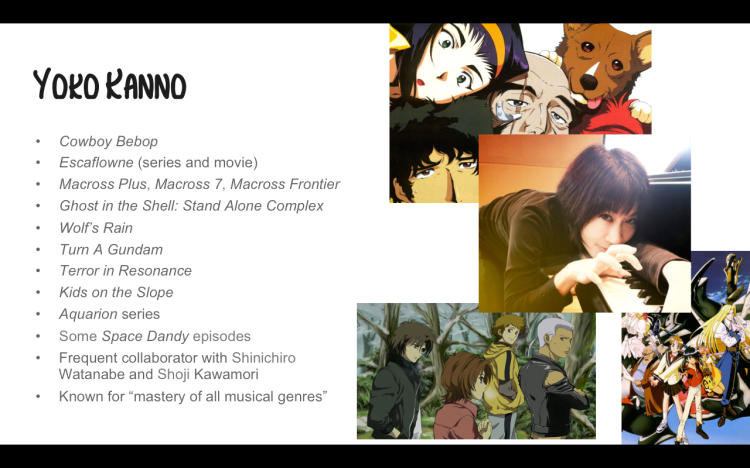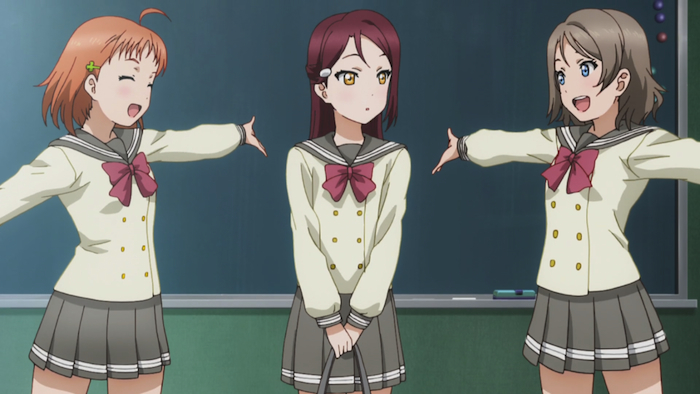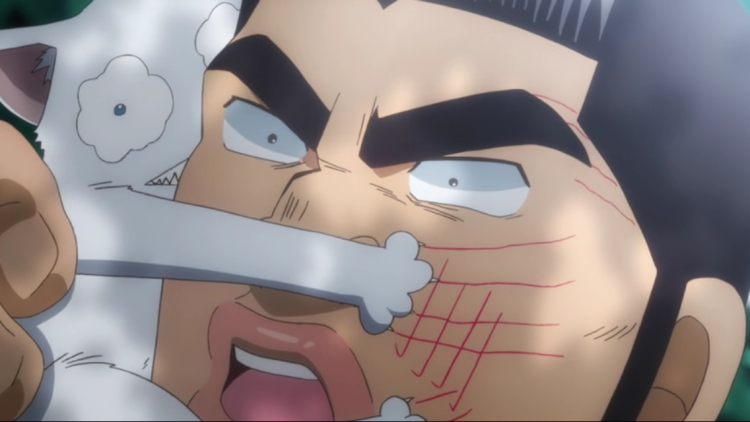Caitlin posted the slides from our joint panel at this year’s Otakon, covering female creative staff in anime. Check it out! We could use some feedback, as we had 20 minutes left and would like to make it longer for future panels.
Category Archives: Anime
Summer 2016 Anime Season: What to Watch – Part 2
Here is the rest of my list of “what to watch in the summer anime season,” with more long-winded explanations for each of them! The previous post is here.
#5 Love Live Sunshine!
I should start this out by admitting that I am a Love Live virgin. I have no previous experience with the franchise, except for a few attempts at the mobile game. So I can honestly say that you don’t need previous exposure to enjoy Love Live Sunshine!, which follows a completely different group of girls from the previous series. You don’t need to know much about it except the premise and that the last series’ idol group was called µ’s (pronounced like “muse”). The new crop are admirers of the old one, with their own personalities and reasons for wanting to be school idols.
“Cute girls in a school club” anime are not really My Thing, so I should explain why I find Love Live so compelling. The first reason is the sheer amount of energy on display in every single episode. This isn’t sleepy, “healing” moe fare: Love Live is excited about idols and wants to make sure that you are, too. Its conflicts are all small stakes, always revolving around Aquors, the new series’ idol group, but they treat every single one like it’s a big deal. Love Live passionately demands your attention at every moment, so you can’t help but be taken in by it.
The other reason is just how good this show looks. Like its predecessor, Love Live Sunshine! has great art and animation. It makes everything feel shinier and more inviting, like you just want to get lost in its happy world. The seaside setting for this particular incarnation of the franchise just adds to this effect. Love Live Sunshine! puts a lot of its out-of-school scenes on or near the beach, making every visit to its world feel like a summer vacation.
I also think, for me, there’s something very familiar and nostalgic about idol shows, with the conflicts so similar to the old-school Hollywood backstage musicals I grew up watching. Maybe I should watch more of them. If they’re as good as this one, I think I’ll have a lot of fun.
Current Episode Count: 5/13. Streaming Saturdays on Funimation.

#4 Thunderbolt Fantasy
So this one isn’t technically an anime, but how could I not include it on this list? Thunderbolt Fantasy comes from the twisted, fascinating brain of Gen Urobuchi, of Madoka Magica, Fate/Zero and Psycho-Pass fame. For real this time: this is not a drill, this is not one where he’s just listed under “story concept,” he’s actually writing the thing. Crunchyroll even has a preview episode that discusses the conception and technical details of the series’ production: Urobuchi went to Taiwan and saw the puppet theater troupe that moves the characters in this show. He loved it, and wanted to make the art form popular in Japan, and so here we are.
Thunderbolt Fantasy is basically wuxia, a type of historical drama that’s China’s version of our lords-and-ladies medieval fantasy. The plot is a fairly straightforward version of the genre, but where Urobuchi sells it is by turning the camp up to 11. Thunderbolt Fantasy knows the whole idea of “puppet TV” is kind of silly, and what’s more, the puppets need exaggerated movements and speech in order to fully come off as “human.” It gives it a really strong charm that helps to sell the silliness of the plot.
It’s hard to tell yet if Thunderbolt Fantasy will show any of the same moral dilemmas or character archetypes that are familiar from his other series. But it’s definitely fun, and hopefully leads to a whole new trend of campy puppet shows from other anime auteurs.
Current Episode Count: 4/13. Streaming Fridays on Crunchyroll.
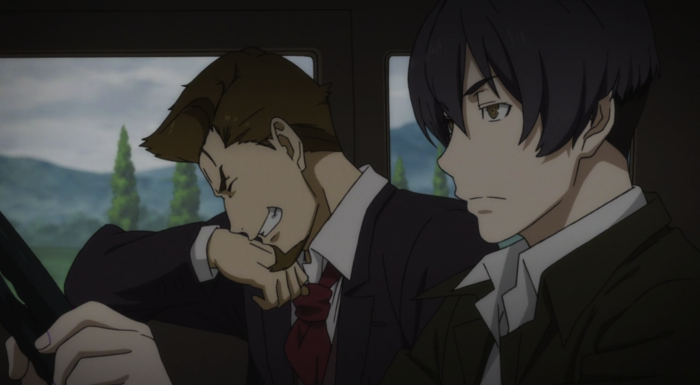
#3 91 Days
91 Days is a pretty basic story: set in the Prohibition era in the United States, a young man returns to the town where he grew up on a mission. The mob killed his entire family except for him ten years ago. Now, he wants his revenge, and will do whatever it takes to get it–even if he has to compromise his remaining humanity for it.
There are so many stories like this in anime, and so many in the “gangster” genre worldwide. I think what makes 91 Days stand out from other “gangster” anime, such as Baccano! and, well, Gangsta, is how much it’s in dialogue with the previous works in that genre. It’s not just the obvious visual reference to The Godfather films in the series’ logo or in events like structuring a key plot point around a mob boss’s daughter’s wedding, but arguably the whole thematic struggle of how the bonds that make us most human can lead us to actions that deprive us of our humanity. So many mafia stories are rooted in the fact that people do these awful, bloody things for family.
91 Days is also indebted to film depictions of rural early 20th-century America, especially road movies. It’s an interesting mix of genres, along with the character focus and more drawn-out, breathable story typical of anime TV series. There is a lot more that I can say on this point, but I want to write a longer post about this series, so I’ll leave it there.
Oh, and it easily has the best soundtrack of this season, or at least tied with my next choice. That’s enough reason alone to check out this anime riff on a very American genre.
Current Episode Count: 4/13. Streaming Fridays on Crunchyroll.
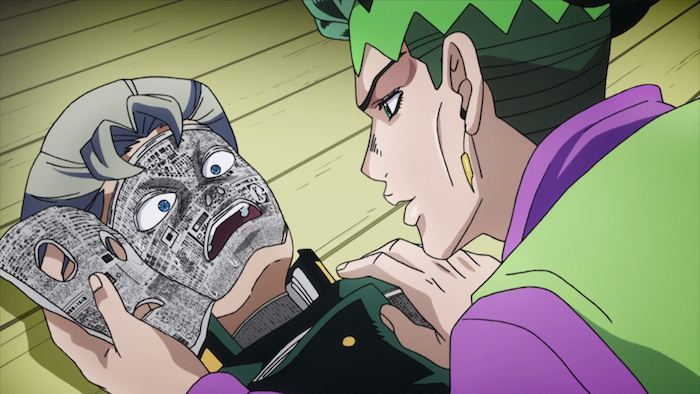
#2 Jojo’s Bizarre Adventure: Diamond is Unbreakable
This is the one exception to the “get in now so you can catch up to it” rule: the current Jojo’s is now 18 episodes strong, and it relies on a lot of references to the previous arc at first. You can’t really go into Diamond is Unbreakable blind. It’s very well-worth the engagement, though, because Jojo’s continues to be excellent, in a way completely different from the series that came before it.
Jojo’s Bizarre Adventure always involved some epic good-vs-evil battle, even if it played out in different ways across those first three arcs. Diamond is Unbreakable starts that way, but as former enemies turn to Josuke and Koichi’s side, it’s becoming clear what the point of the series really is: suburban teens goofing off, but with superpowers. And because it’s Jojo’s, and it’s goofy and over-the-top and also has top-notch production values, it’s strongly compelling. It might just be my favorite Jojo’s arc, and not just because it’s doing a great job with the sort of stories I tried and failed at as a teenager. I think it gets at a really tonally accurate depiction of suburban life, in a way all the moodier ’90s fare about it that I think the show is building off of didn’t. It’s not that bad, but it’s not that great, either. It’s mostly just weird, and also kind of boring unless you try to have fun with it. A lot of being a suburban teen is finding ways to have fun with it.
Diamond is Unbreakable is basically the version of suburbia that suburban teens wish it was: all the creature comforts but with just a little more excitement to them, to spice them up.
Also, the Stands are amazingly weird, as the picture shows. Rohan is a great addition to the group, a manga artist who lives pretty much purely for his craft, constantly in search of more story material and not caring who he has to cross to get it. Of course, he has a stand perfect for it, that just reflects how much more interesting the Stands are getting as Jojo’s moves further and further away from the theme-based “logic” of the Stardust Crusaders ones. The sky is the limit now, and anything goes. And against the mundane suburban setting, it just makes the weirdness all the more pronounced.
I haven’t read the manga, so I have no idea where the show is going with this. But I don’t care if it’s building to an epic confrontation with a Big Bad, or if it’s just another season and a half of Josuke, Okuyasu, Koichi and Rohan finding goofy ways to entertain themselves in Morioh. Either way, I’m game.
Current Episode Count: 18/39. Streaming Fridays on Crunchyroll.
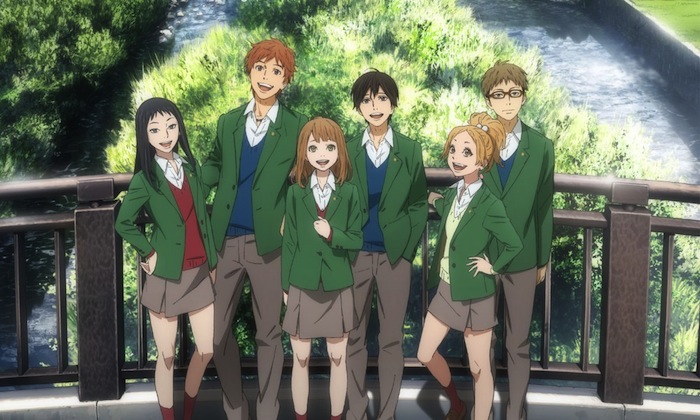
#1 Orange
Yep, the atmospheric teenage melodrama about suicide, romance and time-travel is my no. 1 pick for the season, surpassing even the inimitable Jojo.
I am also planning to write a longer post (or set of posts) about Orange, so I don’t want to use this section to spoil too much of that. But I think I should go into detail a bit about why this show wows me so much, because this genre isn’t usually the sort of thing that blows me away to the extent this series has.
Orange is just really good at capturing the emotions and high-stakes of adolescence. Something like Mob Psycho 100 tells, but Orange shows. It manages to find the perfect middle-ground between the extremes that anime usually goes to in depicting adolescence. It’s never too over-the-top or too subdued to be unrealistic. Not that there is anything wrong with either of those approaches, but it makes something that reaches for the perfect, most accurate middle feel refreshing.
I don’t think I’ve experienced an anime series that really got the emotional roller-coaster of adolescence since Paradise Kiss and Beck: Mongolian Chop Squad. Osamu Kobayashi was really good at that, in fact. Until he’s directing series again, we’ll always have Orange.
Current Episode Count: 5/13. Streaming Sundays on Crunchyroll.
Summer 2016 Anime Season: What to Watch – Part 1
So a few weeks ago, I said I would do a sort of “summer season so far” post. Well, when you’re writing a book, it has a way of catching up to you and delaying all your other projects. Still, I wanted to make sure I had this done before the first month of the season was over, so here we are.
We’re now several episodes into each of these shows, making it a little less “preview” than I wanted. Luckily, we’re only at episode 4-5 at most: so there’s still plenty of time to catch up anything you weren’t watching. And there’s a lot to watch: summer has an incredible number of shows, and a pretty high number of them are worth a shot! There’s a little bit for everyone, from comedies to dramas, to sports to idol shows, to slice-of-life. There are even a couple of historical fiction series. (Is it just me, or is anime making more of those? I like this trend. Please continue.)
This was originally a single post, but it was getting crazy long, especially for the higher entries. So I’m going to put #6-12 on here. The top 5 will go up later this week. This list will not include short series, but I might do a post on them later.

#12 Cheer Boys
I don’t think there’s ever been as fangirl-friendly a premise as “boy’s cheerleading team.” I’m definitely of the fangirl mode in a lot of my tastes, so I went into Cheer Boys expecting to love it.
I didn’t…at first. The first episode was a little slow-paced, and it wasn’t helped by the occasionally sloppy animation. Luckily, by the second episode, it was already a lot better, and kept improving as the group added more members.
What’s interesting about this show is that, even though everyone is based on the same archetypes as every other sports show (for example, the glasses character has a very similar personality to Rei from Free!), they feel and act more like real people. They’re like the more realistic, grounded versions of those archetypes. Watching Cheer Boys, you feel like you’re sitting in on a real college club as they get themselves together.
Oh yeah, that’s the other thing: these characters are in college. How often do we get that in anime? So many high school shows, so few college ones.
Current Episode Count: 5/12. Streaming Tuesdays on Funimation.

#11 The Morose Mononokean
The Morose Mononokean follows a boy named Ashiya whose first day of high school is ruined by an energy-stealing yokai (a sort of Japanese nature spirit). When he calls an exorcist after many unsuccessful nurse office visits, he gets the creature off his back, but to pay for the service he’s now working as the exorcist’s assistant. This leads to Ashiya gaining a deeper understanding of these quirky creatures he’s supposed to exorcise, and the colorful world from which they came.
If this series is low, it’s only because this season is so stellar. If you’ve been reading my ANN reviews, you know I’m loving The Morose Mononokean. Its most recent episodes weren’t quite on the level of the previous three, but there’s still a lot to love about this show–and that sets it apart from other supernatural comedies.
Where others just stick to the biting humor, The Morose Mononokean has a big heart, making you well up with tears when you’re not laughing. It’s almost better at being a heartwarming slice-of-(magical)-life than it is at being funny, though there are lots of laughs to go around, too. Each yokai has a cuddly story that teaches a lesson about the need to appreciate, understand and value all life, making The Morose Mononokean sort of like a bishonen comedy version of Mushishi. Not nearly on that show’s level of quality, of course, but still a very special thing on its own.
Current Episode Count: 5/13. Streaming Sundays on Crunchyroll.

#10 New Game!
I didn’t expect to love New Game! as much as I am, but from the first episode, I was hooked. Maybe, between this and Shirobako, “workplace comedy” is my kind of moe show, because this series is one of my most anticipated going into each week.
New Game! follows Aoba, a teenage girl fresh out of high school, and living the dream as a video game character designer. She’s at the company that made her favorite game, and now she gets to work on the sequel! Along the way, she meets the colorful characters who populate this all-female company, from a shy girl who can’t talk except through IM, to the goofy head of the art department who sleeps by her desk in her underwear.
The show doesn’t include nearly as much about game design as Shirobako did about anime production, so you might be a little disappointed if that’s why you’re watching. (There are a few details here and there, though, especially in episode 3, where Aoba has her first real crack at creating NPCs.) What it is great at is capturing the experience of your first job, and the camaraderie among female friends striving for their dreams. Which is another really strong thread in Shirobako, so if you loved the relationships on that show, I’d highly recommend checking out this younger sister anime.
Current Episode Count: 5/12. Streaming Mondays on Crunchyroll.
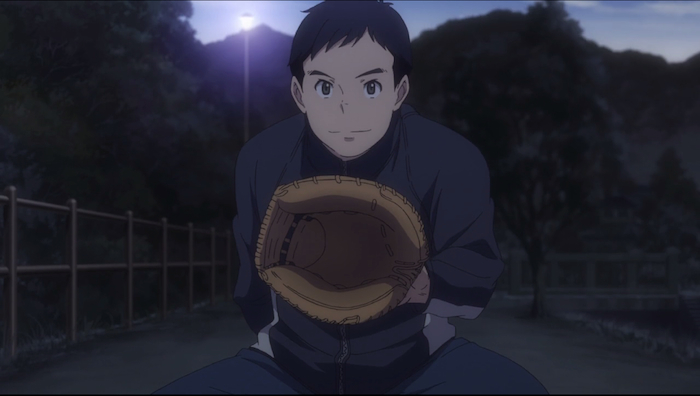
#9 Battery
Amazon’s first show from its deal with Noitamina was the very atypical Kabaneri of the Iron Fortress, a bombastic action show from the director of Death Note and Attack on Titan. It was a strange expectation-setter, when most of Noitamina’s shows tend to be more understated teen dramas and slice-of-life. Battery is closer to that mold, as a baseball anime about the friendship between two boys, from the creator of another Noitamina series, No. 6. Which, of course, means it might turn out to be something more than friendship down the line, but it’s hard to tell from these early episodes.
Either way, Battery is a very soothing character drama, the sort of series that gets labeled iyashikei (or “healing anime”). That might make it too slow for some, and it was for me at first, but it’s slowly crept into my heart as the episodes have worn on. This one doesn’t grab at the strong emotions of adolescent life the way that something like Orange does, but it has that same understated appreciation for the complexities of teenage relationships, whether that be with friends, family or their passions (baseball).
Current Episode Count: 3/11. Streaming Thursdays on Amazon Prime.
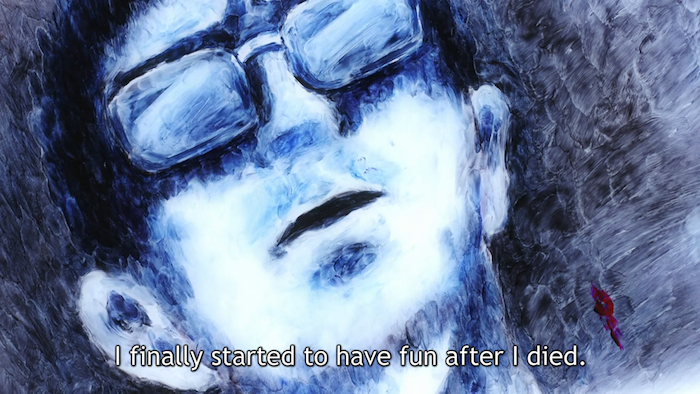
#8 Mob Psycho 100
What a visual marvel. Mob Psycho 100 comes from the same mangaka as One-Punch Man, and reflects ONE’s iconic character designs just as that series did. Mob Psycho 100, though, takes it a step further. It’s animated by Studio BONES, and they take the series through a dizzying array of art styles. The second episode alone ranges from charcoal drawings to actual painting effects (as seen above). The featured image for this article is also from the series, just to get a sense of its range of art styles.
Originally, I had this series lower on the list because it seemed too thin on the plot and characters. Mob Psycho 100 is comedy about a psychic teenage boy trying to figure out his place in the world, while he works at an exorcist shop. (Is something in the water this anime season?) It’s funny and self-aware, with nods to other anime. It has nothing on One-Punch Man‘s affectionate parody of shonen superheroes, but it’s a hilariously surreal walk through teenage life in its own way.
And as of episode 3, it’s started to show some serious promise of its own on the writing front. The third episode featured a strange cult that hypnotized its followers into laughter and happiness, no matter how skeptical they were…everyone, except protagonist Mob, because he has no emotions. Rather than dismiss him as creepy and weird, Mob Psycho 100 decides to explore this side of Mob, and the social consequences he’s felt for lacking such a basic component of humanity. When the cult leader continues to push this button…let’s just say it does not end well for him.
So, bit by bit, Mob Psycho 100 is revealing its cards, making it clearer what kind of story it wants to be. Still, it’s the aesthetics that make Mob Psycho 100 such a marvel, They’re like nothing you’ve ever seen before in anime, and make the series well worth checking out.
Current Episode Count: 4/12. Streaming Mondays on Crunchyroll.

#7 Sweetness and Lightning
Sweetness and Lightning should be familiar for fans of Bunny Drop (before the latter got gross, anyway). It’s the sweet story of a single dad and his daughter. In this case, it’s not that the daughter is adopted, but that her mother has passed away. Her father has to learn how to care for his preschool-aged tyke all on his own, while also navigating his job as a high school teacher. Luckily, he makes friends along the way, including with one of his students, whose family owns a restaurant and who helps him with making meals for his daughter when her mom is away.
The series lives up pretty well to the first word in its title. It’s basically just a big chunk of heartwarming every week, as we watch the tiny family make their way through the world. Tsumugi, the daughter on the show, acts like a real preschooler, getting in fights and misunderstandings with her friends at school, excited and curious about everything she comes across in the world. The relationship between the dad, Kohei, and the student, Kotori, so far shows no chance of heading into Creepytown. They’re just people who’ve found a family of their own in the absence of their real ones.
Oh yeah, and the food always looks delicious. The series also shows them making it step by step, so maybe if you paused a lot you could take down the recipes yourself!
Current Episode Count: 5/12. Streaming Mondays on Crunchyroll.

#6 Planetarian
Planetarian is based on a Key visual novel, a phrase that comes with a lot of baggage. What makes this one different is that it’s a pretty early work from the studio, pre-Clannad, that’s just now getting an OVA. There’s a cute, sad girl, but the story has a strong emotional core based in real human feeling. That’s despite the fact that the girl is a chipper robot living in a post-apocalyptic wasteland.
The robot girl runs a planetarium and still enthusiastically greets any “customers” and offers a presentation, oblivious to the changes in her world. The story is based on her encounter with a gruff, jaded man who stumbles into the planetarium. There’s a cliché Manic-Pixie-Dream-Girl sheen to the premise, of the cute, perky girl who has a brief encounter with a sad boy and gives meaning to his life, etc., but I think there’s more to Planetarian than that. There’s also a larger question about what life does mean in such a bleak, uncompromising world, where all the usual trappings of civilization are gone. As of the most recent episode, I get the impression that Yumemi, our robot girl, is wiser to the realities of her life than she lets on, and her continuing to play the planetarium attendant is her way of giving her life a purpose.
Planetarian also just appeals to me as someone who always wanted post-apocalyptic stories to be more about the people and less about the circumstances of their world’s demise. Sure, that stuff is fascinating in its own way, especially if there’s some meaty theme behind it, but don’t you always wish you knew more about everyday lives in these hypothetical futures? I did. Planetarian is pretty much all character drama, with very little fleshing-out of the world beyond the characters’ mundane observations. It’s a really simple, but surprisingly effective thing.
Also, it’s only five episodes! So when it finishes this week, you could breeze through it in an afternoon.
Current Episode Count: 4/5. Streaming Thursdays on Funimation.
That’s all for now! Tune in later this week for the top five.
Spring 2016 Anime in Review
I haven’t written as much about streaming anime here for a few reasons: a) I’ve been really busy with other projects, and b) I’ve had really bad anime burnout for several seasons. Covering every single show last spring (a whole year ago!) didn’t help, and contributed to my malaise with updating this blog. Luckily, sometimes all it takes to get you out of burnout mode is one really good season, to remind you why anime is good and why you got into it in the first place. That’s what came along for me for with this past season.
This spring season was very strong, with a whole bunch of stuff I really liked and kept following to the very end. I wrote about a couple of my favorites and my least favorite for ANN’s new “best and worst of the season” feature, so those three will have shorter impressions. Somehow, I still found more to say, along with the detailed explanations of how I felt about the other seven titles on this list. Here we go!

#1 Flying Witch
Flying Witch is, to me, the gold standard of iyashikei (or “healing”) anime, up there with Mushishi, Kino’s Journey and the like. Granted, I didn’t love it quite as much as those shows; they’re thought-provoking as well as soothing, while Flying Witch is just really good at being soothing. I found myself looking forward to it week after week, more than any other show—because it was a break from my problems, but it also presents an engaging fantasy world filled with fun, lifelike characters that made it easy to see myself in it.
You can watch all of Flying Witch on Crunchyroll.
#2 Jojo’s Bizarre Adventure: Diamond is Unbreakable
My order shuffled a bit since the ANN Best and Worst. I debated hard even at the time whether to put this or Tanaka-kun second, and ultimately concluded—after I’d submitted my write-up—that Jojo’s was probably the more deserving title. As zany and nonsensical as Jojo’s is, especially this season, it knows how to have a good time better than any other anime. It always has stellar animation, art and music (even if it can’t quite reach the amazing soundtrack of the previous arc, Stardust Crusaders, this one is still up there). It’s uproariously funny, in the kind of genre-parody way where you’re not totally sure if it’s intentional or if the creator is just a very strange person (and the introduction in this arc of his “self insert,” the mangaka Rohan, makes the latter theory all the more likely).
Diamond is Unbreakable might be my favorite Jojo arc yet, though, which is no easy feat because I love them all. The main characters are all lovable and fun, the Stands and conflicts around them are even weirder, and it’s all about how incredibly bizarre suburban life can be. It’s immediately relatable to someone who hated the suburb she grew up in, but at the same time, remembers how much fun it was to explore as a kid. Something about suburbia’s aggressive normalcy makes you think there’s always a skeleton lurking around in some closet—and in Diamond is Unbreakable, this is as true as it will ever be.
You can watch the current episodes of Jojo’s Bizarre Adventure on Crunchyroll, with new episodes every Friday. I highly recommend watching one of the earlier arcs before beginning Diamond is Unbreakable.
#3 Tanaka-kun is Always Listless
Tanaka-kun started off living up to its title, but it quickly improved as it introduced more characters and more jokes. Ultimately, it was that strong characterization and consistent, varied humor that lifted it ahead of Haven’t You Heard? I’m Sakamoto among the zany school comedies this season, even though I wasn’t initially watching it and only picked it up partway through the season. It didn’t matter; Tanaka-kun is as much of a joy to binge-watch as it is to watch weekly. It bears some similarities to Monthly Girls’ Nozaki-kun, although it isn’t quite on that series’ level of comedic excellence. It just manages to do similar things well in its own, listless way. It was enough that, with the previous two, it was my most anticipated show week after week, and I’m still sad that it’s over.
You can watch all of Tanaka-kun is Always Listless on Crunchyroll.
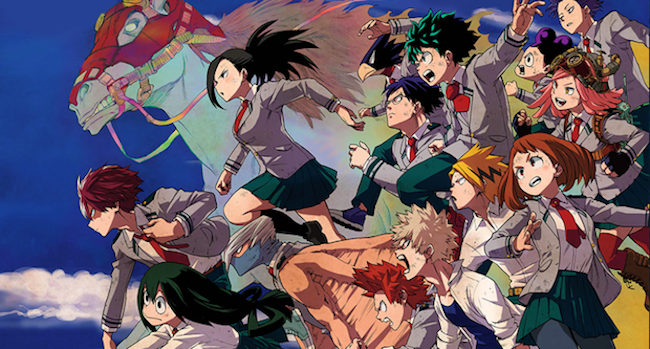
#4 My Hero Academia
I’m going to write a lot about this one, because I feel like a bit of an outlier here: My Hero Academia never connected with me as personally as it did with other critics. To sum it up, it was a little too Weekly Shonen Jump for my tastes. The big shonen hits that got so many of my friends into anime, from Dragonball Z to Naruto to One Piece, have always kind of bored me; it was the more “adult” aspects of anime, not so much the sex and violence but the more thoughtful themes and complicated morality, that got me hooked on the medium as its own thing. Jojo is my one exception, and that’s largely because Jojo feels like a parody of the camp and oversimplicity of shonen battle series.
All that being said, I still had fun with My Hero Academia. It gives you characters that are easy to root for, and there’s a lot of that kid wish-fulfillment feeling about going to a school that teaches how to fight and be AWESOME with your AWESOME POWERS! Deku is one of my favorite shonen heroes ever, and I think a lot of that is because he averts the usual “chosen one” narrative; he’s very much not chosen, but earns his place through his pluckiness and loveable nature. On top of all that, My Hero Academia has the amazing production values to be expected of Studio BONES, including a rousing soundtrack that feels as heroic as its characters.
I guess what I can say is that I liked MHA best when it was closer to the “superhero Hogwarts” side of things. Getting too deep into real battles left me a little bored. When I could focus, though, it was hard to deny MHA is one of the best anime of the year so far, even if it doesn’t reach me as well as it does apparently anyone else. I’ll definitely still be tuning in for the next season. I want to see where these characters and their heroic journeys go.
You can watch all of My Hero Academia on Funimation and Hulu.
#5 Concrete Revolutio
I fall somewhere in the middle of the Concrete Revolutio debate. I don’t think its messiness dooms it; there are still too many interesting ideas there. I do think it keeps it from becoming a masterpiece. Sure, it’s a visual explosion, with top-notch BONES animation, and a quirky comic-book art style that fits its attempt to be a Japanese Watchmen. The period setting made it a lot of fun to figure out which events each episode was referencing (as a Westerner where they wouldn’t be immediately apparent), and made it a loving homage of 1960s-70s-era anime superheroes.
Where ConRevo stumbles is with the themes, where it also promised as strong of a pedigree, especially considering who worked on it: director Seiji Mizushima and screenwriter Sho Aikawa, who also made my favorite anime, the first Fullmetal Alchemist. FMA manages the balance between the timeless/universal and the pointedly political far better than ConRevo does. The latter ultimately settles for a surprisingly simplistic theme about the need for the ideals heroes provide even in a complicated world, one that I’m not sure justifies its historical setting and political references. That and the weak character development (especially for the female characters) keep it from the top for me. Still, it raises plenty of interesting ideas along the way, and I still wholly recommend it for people wanting an anime that rewards their brain as well as their eyes and ears. This is especially true of the season that aired this year, which put aside the first half’s confusing attempts at character- and worldbuilding to tell a strong, cohesive set of stories.
I can’t believe I wrote this much about a show that I’ve already written so much about in my reviews for ANN. Go read those if you want my full take on this strange, uneven, but exciting and ambitious show. You can watch all of Concrete Revolutio on Funimation. The first season is also available on Hulu.

#6 Joker Game
Joker Game had a really intriguing first episode, that seemed to be setting up for a series that had a lot to say about World War II and the spies’ role in it. It had a few more episodes like that…and then it set into a pattern with that early potential not really going anywhere. It became clear Joker Game was just a cold period spy thriller, featuring a different character each episode. While the series did overall have a cynical worldview about war and the people who made it their business, it seemed to eschew politics in favor of just letting us into the lives of the spies. Unfortunately, it didn’t really do that either, because of the lack of character development for its spy leads. It was easy to believe at first that this was just a function of the episodic nature of the show, where each spy had his different day in the limelight. Yet at the end of the show, it confirmed this was the point; the show upheld the idea that spies are better spies when emotions and human connections don’t get in the way.
Like many western-style dramas, especially period pieces, Joker Game had the potential to reach a wider audience outside of anime fandom. Instead, it narrowed its audience, to two groups that don’t have much overlap with anime fandom: fans of fancy-looking historical dramas, and fans of terse spy thrillers. Luckily, both of those groups include me, especially the first one, so I enjoyed this extremely well-made (and, especially, well-scored) iteration of those. But even for me, this show exists in the shadow of what it could have been, especially a season after one of anime’s best period dramas, Showa Genroku Rakugo Shinjuu.
You can watch all of Joker Game on Crunchyroll.
#7 Kabaneri of the Iron Fortress
At its best, Kabaneri of the Iron Fortress was a non-stop thrill. Its visuals were so top-notch it almost felt like watching a Ghibli movie in its landscape scenes, especially with its mix of the historical setting and fantastical circumstances. Of course, once the plot starts up again, you remember immediately this is actually from the wild mind of director Tetsuro Araki, with its ultra-violence, frenetic action sequences, and pumping soundtrack (provided, as usual, by Hiroyuki Sawano). Kabaneri is Araki at his most Araki, inviting automatic Attack on Titan comparisons with the zombie-like monsters destroying what remains of humanity and the fighters floating around in their 3D gear. Unfortunately, Kabaneri was never as strong in its characters or themes as Attack on Titan; it was more purely pulp, and even the plot fell apart in the second half. I’m not sure if Attack on Titan was ever as energetic as Kabaneri, though, which helped keep it chugging along as the ever-cheesier plot twists threatened to derail it. (Okay, no more train jokes.)
You can watch all of Kabaneri of the Iron Fortress on Amazon Prime.

#8 Space Patrol Luluco
Space Patrol Luluco was a great dose of nugget-sized fun every week. I really loved it when it was a cute little story about Luluco trying to rescue her dad, and falling in love with another space patroller. It moved away from that in its later episodes as it became more of an extended homage to other Trigger and Imaishi anime, from Kill la Kill to Little Witch Academia to even Imaishi’s Japan Animator Expo short, SEX and VIOLENCE with MACHSPEED. Trigger is great at poking fun at itself, and I’ve seen most of this stuff so I get the references. Yet that shift in focus was away from what I liked the most about Luluco, the heartfelt little story that was at its core. I’d still highly recommend Luluco, but anyone starting now is probably better off, because they’ll know what they’re in for.
You can watch all of Space Patrol Luluco on Crunchyroll.
#9 Haven’t You Heard? I’m Sakamoto
I didn’t end up watching through all of Haven’t You Heard? I’m Sakamoto, so it says something that I still feel like it’s worth listing. I found a lot of the show funny, but it stretched my patience watching its repetitive gags play out over an entire half-hour. I think Sakamoto would have been better as a short anime, especially in this era that’s shaping up to be the golden age of under-five-minute series. Sakamoto excelled for me in the moment, but struggled as quarter-hours (to paraphrase a famous quote about Wagner’s music). I’m sure I’ll get around to finishing it eventually, but I’ll always wonder what could have been.
You can watch all of Haven’t You Heard? I’m Sakamoto on Crunchyroll.
#10,000 Kumamiko: Girl Meets Bear
I already wrote a detailed take-down of the final episode of Kumamiko: Girl Meets Bear in my final review of the show and my Best/Worst of the Season for ANN. I’ll just say here that I’ve never seen a show tank so hard in the space of one episode, and in a way that feels like it’s designed to give somebody the middle finger. Whether that’s the fans or it was just supposed to be someone on the creative team (with the fall-out that occurred on social media around the time the episode aired), it certainly reverberated for all involved as it was also a huge insult to the characters, with negative character development dooming them to the worst possible fates. Sure, the show always had issues with its portrayal of Machi’s social anxiety, and how it reveled in her and other female characters’ discomfort, but it at least usually ended on a hopeful note and had enough genuine laughs along the way to keep you happy. Not so with this mess of an ending, the kind that casts a shadow on the entire show.
If you must, you can watch all of Kumamiko: Girl Meets Bear on Funimation.
Next up: I’m posting a summary soon of how I feel about the Summer 2016 series so far, and possibly some episode recaps for my two favorite shows this season.
Since I’ve Been Gone…
Hey blog followers!
I know that most of you follow me somewhere else on social media or on ANN, so you are likely updated on my recent projects. Still, I thought it would be a good idea to post a list of what’s kept me so occupied since I last posted on this blog.
First of all, I just finished the first year of a Ph.D. program in musicology at the University of Texas. That’s kept me busy with classes and all the writing and research that goes with them. If you want to read up on my academic work, I have an Academia.edu account where I post most of my papers when I am finished with them. Some recent highlights include:
- “Everything You Dreamed of on the Edge?”: 1980s Generational Anxieties in the Music of The Brave Little Toaster (presented at the 2016 Society for American Music conference in Boston, March 9-13, 2016) (Note: because I might adapt this into a longer journal article at a later date, I’ve made the decision to remove it from my Academia.edu account. Please let me know if you would like to read it.)
- Music, Violence, Propaganda and Action Spectacle in the Hunger Games Film Series
- “Be Art or Sing It”: Camp and the Grotesque in Horror TV Presentations of Opera (includes discussion of operatic encounters in Buffy the Vampire Slayer and Black Butler)
More importantly and more excitingly, though, I am writing a book! It is a part of the 33 1/3 series published by Bloomsbury Press; you might have seen their guides to famous rock albums in bookstores. They’re launching a new “33 1/3 Japan” series, and I will be writing one of the first titles in the series: a guide to the Cowboy Bebop soundtrack!
You can read more of the details of the series on our editor, Noriko Manabe’s website here. There is also a form for submitting a proposal if you know a lot about Japanese popular music (including other anime soundtracks) and are interested!
With all that plus teaching a rock history class this week, I have a busy summer! But a very fruitful one. I hope to produce more for the blog soon, but in the meantime, please enjoy what I have written in my absence!
[03/07/2015] Comments from Director Seiji Mizushima and Scriptwriter Sho Aikawa
If you’ve been following my reviews of Concrete Revolutio over at ANN, you might find this interview with the creators that Frog-kun translated interesting!
Apologies for not updating this in a long while; I’ve been very occupied in writing my book and other projects! I’m hoping to get some more entries on here this summer.
-Rose
Original article: 水島精二監督、會川 昇(脚本)よりコメントを頂きました Seiji Mizushima (Director) Why were there so many superheroes in our make-believe stories? It’s been almost ten years since I had that conversation wit…
Source: [03/07/2015] Comments from Director Seiji Mizushima and Scriptwriter Sho Aikawa
Around the Internet: “Why You Shouldn’t Start With Sailor Moon Crystal”
Hey, readers! Long time, no see!
I’m eternally frustrated by my inability to maintain this blog on a regular schedule, but I’m trying a new approach. If I can’t think of a more substantive post, I’ll write some commentary about something elsewhere on the Internet that I like. This time, it’s this video that’s been floating around the Anime Internet, about Sailor Moon Crystal:
YouTuber CJ outlines why newbies to Sailor Moon should skip the reboot series, and stick with the classic anime and manga. It probably isn’t a surprise to anyone that I agree with her. I tried to be positive about Crystal at first, but ended up coming down pretty harshly on it as of my Twelve Days of Anime post about the franchise. There’s simply not much to recommend about it to newbies or diehard fans–or, really, anyone other than hardcore completionists. (Which might be me; I couldn’t finish the second cour, but it lingers on my Hummingbird “on hold” list.) Apparently there’s some disagreement in the fandom about that, though–not as much as I think she makes it out to be, but maybe we’re not hanging out in the same places. CJ does a great job of explaining her points while addressing those disagreements–such as the issues with the 1992 anime and original manga. They have them! That still doesn’t make Crystal good.
There are lots of posts about this around the Internet, though, so here are two specific things I really appreciated about CJ’s video:
- I love that she gives a good word for the live-action series. I don’t agree with her in recommending it to Sailor Moon newbies, or at least ones who aren’t already familiar with anime or live-action Japanese television. Its cornball acting and bad special effects are pretty big hurdles for people who aren’t expecting them. However, if you can get past that, there is some really strong writing in there. I wholeheartedly agree it’s probably the best version of the “Dark Kingdom” plot (the first arc of the anime and manga)–even if there’s none of my beloved Zoisite/Kunzite. All the Senshi’s full personalities and home lives are explored, making them and their episodes just as interesting as Usagi’s to a degree beyond even the original anime. It’s also the best version of the Usagi/Mamoru relationship, making them truly star-crossed lovers and integrating their romance into the central conflict. Sure, there’s also some silly stuff like the plushie cats and “Sailor Luna,” but at least it totally owns those. Highly recommended if you’re at all interested in Sailor Moon—and you know what “tokusatsu adaptation” entails.
- Other Sailor Moon fans will probably kill me here, but I enjoyed her recommendations of more modern magical-girl fare at the end. I haven’t seen Yuki Yuna is a Hero (and I’ve heard mixed things), but I loved Puella Magi Madoka Magica and, endless arguments about its “feminism” aside, it’s probably more relevant to the modern anime viewer than Sailor Moon is. It’s actually hard to know who to recommend Sailor Moon to these days. Even as someone with strong nostalgia for it, I can acknowledge even the best versions of the series still feel pretty dated. It’s a super-popular classic that every anime fan should probably have some familiarity with, and if you’re a credits-chasing sakuga type, it’s cool to see what Ikuhara, Junichi Sato, Enokido and co. were doing back in the day. But if you just want to get into the magical girl world, there are better places to start now.
What do you think about Sailor Moon Crystal and its merits/lack thereof? Which parts of Sailor Moon would you recommend for new fans? Let me know in the comments!
Cool Old Anime: GoShogun The Time Etranger
It’s hard to find old anime that’ll appeal to younger fans. I’m not talking about anime from the early 2000s or 90s. I’m talking mid-80s, when I didn’t even exist yet. We’re lucky to live in an era where companies like Discotek and Crunchyroll are making older anime more available for our viewing pleasure, but the big question remains: where do I start? If you’re looking for an anime that’s obscure, old, and unique, might I recommend GoShogun: The Time Etranger, released in the US under the name Time Stranger?
Time Stranger seems like an oddball choice to recommend, given that 1) it’s out-of-print currently (though copies of the Central Park Media release aren’t hard to find as of the time of this writing) and 2) it’s a sequel to a TV series that never got an English release. Last I checked, there aren’t even fan translations of the GoShogun series, but feel free to correct me on that. However, aside from a GoShogun model toy making an early cameo appearance, there’s no direct indication that this is a sequel to a mecha anime. To the uninitiated viewer, the characters could have been a part of any military organization and it just so happens they’re living in a future with hovering cars. Also, one of the guys is a giant blue man, but that never bothers anyone. Thankfully, knowledge of Goshogun isn’t necessary to understand the story as Remy is fleshed out wonderfully as a character.
The story begins with Remy Shimada, a woman in her 70s, getting into a car crash after a badass chase scene and winding up in a coma. Her friends from her GoShogun years come to see her, but the doctor tells them that she has a 5 percent chance of living due to the severity of the crash and other medical complications she was hiding prior to the crash. Even after pulling all the strings they can to save her, she’s given 2 days to live. In her comatose state, Remy fights in a mysterious city where escape is impossible and everyone is trying to kill her. She’s given a letter telling her she has two days to live. All Remy has is her determination, her revolver, and her friends.
Remy is actually experiencing two dreams. The main dream takes place in a city 40 years ago, which looks like it could take place in the Middle East given the mosque-like structure in the middle of the city the denizens pray to daily. The other dream is a flashback to Remy’s childhood in France. She lost her mom when she was young and became a street urchin. Kids would harass her but she would fight back, proving that even as a little kid, Remy was still the coolest.
The film never explicitly indicates how much of what we see in Remy’s comatose state is her actual memory and how much is just her dreaming, but it’s for the better. Not explaining adds to the surrealness of the situation and allows the central metaphor of fighting death. When I first saw this film, I was reminded of Satoshi Kon’s Millennium Actress, another film about a woman experiencing flashbacks to her past at the end of her life. Like Millennium Actress, memory and dreams mingle to the point they’re indistinguishable While not as visually ambitious as Millennium Actress, the same idea about how our memories define our lives is why I love Time Stranger. Remy remembers the two points in her life where she felt like she would die, but she managed to find the determination to escape death. Overcoming impossible odds through sheer determination is an old anime cliche, but few anime show an old woman fighting the giant demonic panther that’s the personification of fate with a single bullet and knocking over her own grave at the same time. That’s much more inspirational to me than Goku yelling until he’s strong enough to destroy a planet.
On a side-note, it’s rare to see any anime, today or in the past, invoke Islamic imagery in any way. The words “Islam” and “Muslim” are never explicitly used, but it’s clear what’s being invoked on-screen. They’re a generalized force of fate and order, a surreal religious army inside Remy’s head. For most of the film, the civilians are blank gray-skinned mobs trying to kill Remy and her comrades, like zombies in an apocalyptic world. As far as representations of Islam go, it’s not particularly kind, and if this movie were made today with criticism of media depictions of Muslims being more common, it might be seen as dehumanizing. However, if you take it as a metaphor for religion in general and how it can be seen as fatalistic, it works just fine. Still, watching this movie today made me realize that depictions of Islam in both Western and Japanese media are limited.
The animation is nothing special, and the art is pretty typical for the era; pleasant enough to look at, gets the job done. Some of the sequences are really neat and tasteful, like when Remy has a vision of herself being torn apart, she transforms into a bloody-red outline that falls apart. Remy’s face in the present-day is also never fully-shown, and the film does this by obscuring it with sunglasses or a breathing mask, or by utilizing some first-person perspective. You always get the sense that you’re on her side, not viewing from the outside but from within, even she’s awake in the present. It’s one of the many ways Time Stranger gets you to empathize with her.
At its core, Time Stranger is the story of one woman finding a reason to live when everyone’s telling her it’s her time to die. It just so happens to be the sequel to an old mecha TV series without the mecha, and it’s great. It’s an obscure gem of a film, and those with an interest in 80s anime that’s not Akira or Studio Ghibli should check it out.
Ranking the Anime: Spring 2015 Week 7 (May 15-21)
I’m putting Plamemo on hold until it stops getting mired in rom-com shenanigans. Frankly, I need to put something on hold if I’m going to keep doing this, because I’ll be really busy over the next week or so. I’m heading to a film music conference in New York next weekend, to present a paper on Michiru Oshima’s score for Fullmetal Alchemist! I am really excited, but it means a lot of prep ahead of time. I am probably going to take Week 8 off to focus on my work and having fun at the conference. See you all then!
1. Blood Blockade Battlefront episode 7: I’d recently come to the conclusion on revisiting Trigun that music can do a lot to make up for a low budget and otherwise sloppy visuals. Well, Blood Blockade Battlefront delivers on those fronts, and yet its music still adds so much to each episode. I especially like that each episode has so much stylistic variety, and it still matches so well to every moment. Like this week, where we had operatic strains accompanying Leo meeting with Black and learning about White, and comparing her to his sister’s plight. (I’m not fully convinced White isn’t actually his sister on some level.) And then we had the hard rock for Zapp getting trapped and Klaus coming in to fight. There’s a lot to love about Blood Blockade Battlefront from week to week, and the soundtrack is no small part of that.
2. My Love Story!! episode 7: Full review here. This was probably the single cutest and most romantic episode of My Love Story!!, and that’s no small feat. Most episodes of this show are pretty adorable. This one did a lot to show you just how invested in each other Yamato and Takeo are. The answer: even more than you thought. I’m a little worried about how long My Love Story!! can run on this particular engine, but as for now I’m more than enjoying the ride.
3. Heroic Legend of Arslan episode 7: Full review here. This episode was a huge step up! It really fleshes out the Lusitanian side of the conflict, and gives us a bunch of new, fun characters and dynamics. I’m feeling good about where this show is going in a way I haven’t in weeks, and that’s awesome. Arslan has a ton of potential it needs to stop squandering.
4. Sound! Euphonium episode 7: This episode focused largely on the older students, showing how hard they’ve worked to keep the band alive when the previous seniors quit. Yet for some of them that isn’t enough to keep them in when the band starts interfering with their other dreams, like getting into a good university. This leads Aoi, tenor saxophonist and one of the leaders of the band, to quit. The band is finally the powerhouse she wanted it to be, but it also really doesn’t have room for her anymore if her sax isn’t going to be a priority. Sound! Euphonium in many ways is like the anti-K-ON!: it’s the real-world workings of a school music group, not the fantasy version that show serves up. It’s very refreshing, and the rich character interaction should make it work even for people who aren’t deep into the high school band world. We’ve all struggled with the trade-off between our goals and the things we do for fun. Some people take band as their top priority, like Asuka. For some people, it’s always going to be second fiddle, even if it’s still big enough to fight for it.
5. Jojo’s Bizarre Adventure: Stardust Crusaders episode 43: When was the last time Jojo’s was this straight-up dark? Vanilla Ice sure knows how to bring the terror. Polnareff is probably one of my favorite Stardust Crusaders, but he can be frustrating when you’re expected to take him seriously. Still, this was a strong, interesting battle, especially in watching him and Iggy put aside their differences to defeat such a formidable enemy. I kinda know how Stardust Crusaders ends, but I’m still a little worried for our Boston terrier there. Vanilla Ice and his stand Cream are a terrifying pair, and he and Polnareff are pretty stuck. This is Jojo’s, though, so I’m sure they’ll get it out of in some bonkers way with a rocking soundtrack.
6. Sailor Moon Crystal episode 22: I can’t believe it, but I think this week Crystal was actually kind of good? The plot was easy to follow and the characters had personality (Venus even expressed regret that she’s so powerless during this arc). Usagi actually cared about her friends as much as her boyfriend. I could actually feel for the villains as they got frustrated over their Prince Demande going insane. And Black Lady is already a menacing, mysterious presence. I also think the show saved pretty much all its art and animation budget for this episode, as there was a noticeable lack of mistakes and upgrade in the visual quality. I especially liked the design for Wiseman, Neo-Queen Serenity and the other non-physical “projections,” with textures that reminded me of the character designs in Gankutsuou. Not a comparison I ever thought I’d be making for this show! I hope Sailor Moon Crystal can keep up this level of quality in the last few episodes. I might actually be pumped to watch them now.
7. Fate/stay night: Unlimited Blade Works episode 19: This episode falls into one of the franchise’s major weaknesses: excessive talking that doesn’t translate well to film. I wasn’t as negative on this episode as Gabbo was—in fact, I mostly enjoyed it, apart from the creepy Shinji stuff—but it does make it clear how much they’re stalling for time. Now that we’re coming down the wire to our true, final antagonists in the form of KK and Gilgamesh, I’m not sure how this show expects to fill its remaining episodes. I surely hope it’s not all with Archer monologues.
8. Wish Upon the Pleiades episode 7: Full review here. Well, that sure wasn’t promising. Wish Upon the Pleiades gave itself a tall order last week, but one it could at least take some steps toward delivering. And it…didn’t even try. With the exception of a few moments hinting that something is seriously wrong with Minato, it was all meaningless friendship hijinks. Oh well. Better luck next time? Maybe? I don’t really know what to expect from this show anymore. I’m not sure if it even wants to try.
Ranking the Anime: Spring 2015 Week 6 (May 8-14)
This week was a little more consistent than previous ones. Strong contenders that slipped a little before are back in shape, with some turning in their best episodes. Pleiades is as uneven as ever and Plamemo went back to weaker episodes, but that’s not a huge surprise. They’re both at interesting crossroads, though, so hopefully they’ll get it together for the rest of their runtimes.
1. Blood Blockade Battlefront episode 6: BBB continues to be my favorite show airing, but this might be my favorite episode of the series so far. Trigun is the only anime that’s brought me to actual tears, and while this episode didn’t quite get there, it came close. Yasuhiro Nightow is one of those few creatures who can combine the silly and sad so seamlessly. This week’s installment also sets up well for “what this series is about,” with both Nej’s story and White’s cryptic messages. BBB may be a word full of colorful and creepy-looking aliens, but this isn’t Men In Black: some of them are perfectly benign and even sympathetic, like Nej this week, whose near-“death” broke my heart. The point is that there are good people and bad people, good aliens and bad aliens… good creatures from all walks of life. We have the power to decide who we want to be, independent of our natures. It’s not unfamiliar if you’re used to Nightow’s other work, but BBB may be his most fun presentation of it yet.
2. My Love Story!! episode 6: Read the full review here. We’re back to strong episodes of this show, and ones that dispense or play around with shojo genre conventions. Takeo and Yamato’s love story has the potential to be a different sort of love story, and I’d like to see this anime deliver on that. Really, this week earns high marks just for the Saran wrap scene.
3. Fate/stay night: Unlimited Blade Works episode 18: Here it is: the best episode of this show and the one that spells out its themes. Fate is all about heroism, when it’s worth it and when it’s not, and how it can corrupt. Friends who played the visual novel told me ahead of time who Archer really was, and I’d always wondered how Shirou turned so cold-hearted. FSN: UBW answered all that and more in just a few minutes, in Rin’s artful introspective scene. It’s far from the first anime to deal with this topic, or the best (that would be what Utena did with Dios and Akio) but at least now I can see why the Stay Night half of this has such a fervent following. It doesn’t hurt that, unlike with Zero, this show has the direction its heavy material deserves.
4. Sound! Euphonium episode 6: This was a pretty strong episode, with a heavy focus on Hazuki. When their teacher announces auditions for festival competition, Hazuki figures she’ll just sit this one out, with how new she is to her instrument. She wasn’t even sure if she wanted to play tuba, after all! Her friends (and Asuka, of course) convince her to give it a try. The power of friendship reigns supreme in Sound! Euphonium, but also the power of “ensemble,” the joy of music-making with friends. I really liked this, since the thrill of playing in a large group was a big part of why I loved high school band and orchestra. It’s a very energetic, communal experience, where you’re just feeding off each other. Small groups (like when she practices with the rest of the bass section) have even more potential for that sometimes. My favorite parts of Sound! Euphonium are when it captures some of the excitement of music-making as a teenager, and this week was in prime form for that. It also does a lot to better develop and elevate Hazuki as a character, too.
5. Jojo’s Bizarre Adventure: Stardust Crusaders episode 42: D’Arby the Younger’s ending is very similar to his brother’s, and in that way this episode stumbles. Still, it’s a fitting ending for a very frustrating, silly villain. It’s great to watch Jotaro’s (and Joseph’s) trickery tear him apart at the seams, and in a way that makes it clear just how much he pales in comparison to the other D’Arby. More importantly, the second half of this episode introduces one of the best and most popular Stand users, Vanilla Ice, and shows that stronger, darker, creepier things are to come for the remainder of this arc. Including Dio! Stardust Crusaders has putzed around for long enough. It’s about time.
6. Heroic Legend of Arslan episode 6: Read the full review here. This episode solidifies a lot of Arslan’s ideas about power and what makes for a fair society. That said, the actual episode itself is pretty weak on its own. It doesn’t give us much from the more fun characters, just a larger struggle that makes it obvious to me how much I don’t care about any of the players involved. This feels like transitional stuff, so let’s hope Arslan moves on to equally smart but more interesting pastures.
7. Wish Upon the Pleiades episode 6: Read the full review here. The show finally does something with its larger plot, but it feels too little too late. It comes very abruptly after weeks of character-focused shenanigans, and with such a decisive victory. At least Pleiades has to keep moving forward after this, right? But who even knows with this show. Next week might be back to focusing on drive-shaft training, for all I know and how sloppy its pacing has been up to now.
8. Plastic Memories episode 6: This episode was actively difficult to finish watching. It’s not even the worst episode; the sections focusing on Isla’s feelings about her deteriorating state were strong. Those were at the beginning of the episode (fooling me into thinking this one wouldn’t be “too bad”) and the end. It was everything in-between that stunk, all the silly rom-com stuff between Isla and Tsukasa. We get it: They like each other, and they’re both awkward about and loathe to admit it. There is nothing new about the way the show has built up to or is presenting this. Nobody cares. I just want more of them retrieving Giftias and info about how they work. I like Isla’s personal business when it plays into that, but not when it’s just sitcom hijinks. Plamemo has never been good at that, and needs to stop trying. Just stick to what you can do.



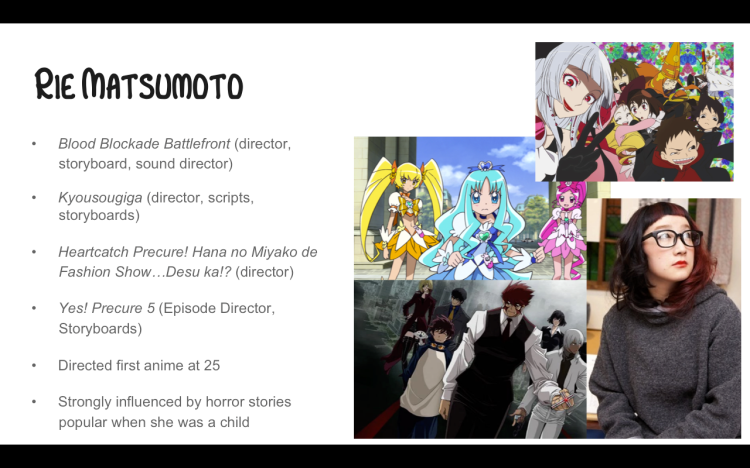
 Video available
Video available 
 Video available
Video available 

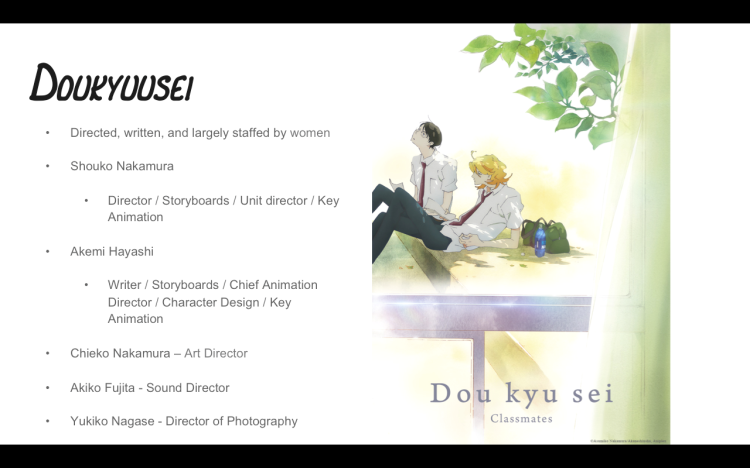
 Video available
Video available 




